Hello anyone got any Irish Lithics?
Announcement
Collapse
No announcement yet.
Irish Lithics
Collapse
This topic is closed.
X
X
-
Not me but I would really like to see some.
TN formerly CT Visit our store http://stores.arrowheads.com/store.p...m-Trading-Post
Comment
-
It’s an interesting question but there are some things you need to know about the pre-history of the British Isles to help understand the answer. When I use the term “British Isles”, that geographically includes “Ireland”, but when I use the term “Britain” I mean the mainland - which excludes Ireland.
The British Isles are geologically part of the European land mass and are joined (beneath the current sea level) to the European mainland along what is now the northern coastline of France, Belgium and the Netherlands. Ireland is in turn also joined to the British mainland along what is now the Irish Sea. The sea level was originally over 400 feet lower than today and – although free movement was possible – temperate flora and fauna did not cross from Britain to Ireland. All but the southern tip of Ireland was covered in an ice sheet getting on for 2 miles thick whereas the majority of Britain was ice-free, although the ice-free parts were largely inhospitable frozen tundra.
The land bridges connecting the three places have come and gone over time as a result of changes in sea level (up and down) as well as through multiple advances and retreats of ice sheets. Britain first became a (temporary) island around 350,000 years ago but has been intermittently re-connected to mainland Europe. The final connection was gradually submerged by rising sea levels from glacial melt-water and the final remnants washed away by a huge tsunami a little over 8,000 years ago.
The earliest known occupation in the British Isles in the Lower Palaeolithic is from around 800,000 years ago on what is now the east coast of England, but it would have been connected to Europe at the time. Thereafter, Palaeolithic occupation has been intermittent and non-permanent as successive ice sheets advanced and retreated. There is for example almost no evidence of occupation in the British Isles between 180,000 and 60,000 years ago. Melt-water from the previous ice age temporarily cut us off from mainland Europe between about 130,000 to 110,000 years ago. All the evidence suggests that Palaeolithic people living in Britain were temporary occupants from mainland Europe who returned there whenever our climate became hostile. They were likely following game-herds, establishing summer camps and the limited evidence for longer-term occupation suggests stranded groups of individuals who missed opportunities for return to their real homelands.
There is no convincing evidence for Palaeolithic occupation of Ireland. If it was habitable at all then whatever evidence there may have been has been crushed under the ice. Europe looked somewhat like this in the period from 70,000 to 20,000 years ago at the glacial maximum:
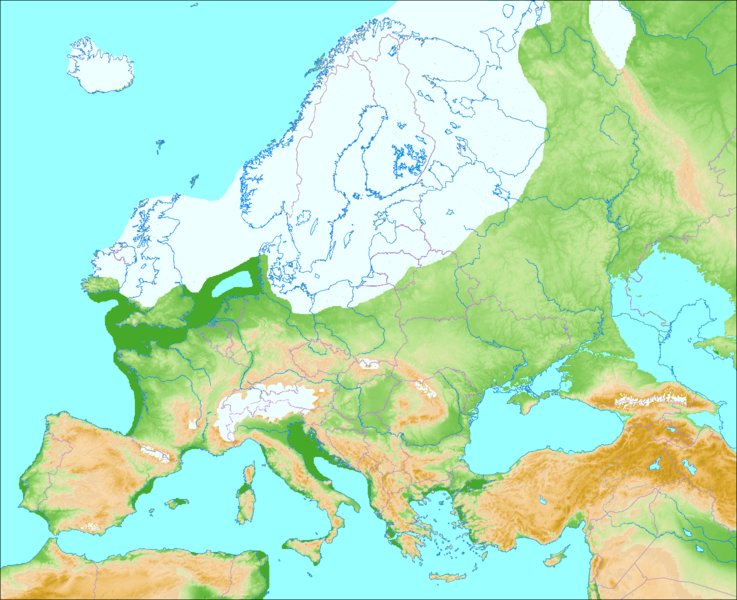
[pic by Ulamm – Creative Commons License]
Note the green areas that indicate southern Ireland and south-west Britain to be a continuous area of land. As the ice began to melt, between about 14,000 to 10,000 years ago, sea levels rose, gradually separating Ireland from the British mainland. It’s possible that limited numbers of hunter-gatherer people crossed into what is now the southern tip of Ireland in the Mesolithic around 9,000 years ago and were stranded there, as this model suggests:
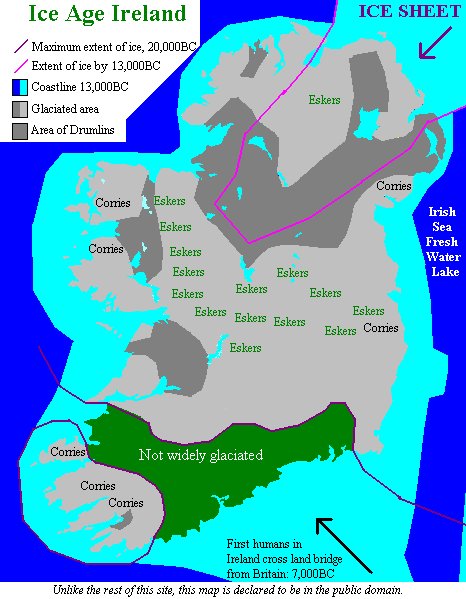
But there is recent evidence to suggest that even the southern tip of Ireland didn’t escape the ice sheet and that the main founding population of Ireland arrived by boat from Britain. In Mesolithic times the population never exceeded an estimated few thousand people and the numbers were boosted by more numerous arrivers between 4,000 and 2,000 years later. Those people definitely arrived by boat from Britain.
That means Ireland launched almost immediately from Mesolithic into Neolithic via temporary coastal fishing communities largely using bone tools and microlith composite tools that were less likely to survive and in places that are now beneath the ocean. Those people gradually moved inland, adopting an agricultural lifestyle using cereal cultivars and domesticated animals brought from Europe via Britain. The red deer was also introduced from Britain a little over 6,000 years ago. The lithic artefact assemblage is almost completely dominated by polished axes which are highly numerous and show little variation in form. This extract is from a 1939 letter sent to an amateur collector in the Tawin area of Galway Bay, who was accustomed to the National Museum of Ireland in Dublin purchasing items from him:
“Dear Mr. Holland, as you are probably aware, I have practically given up collecting these stone axes from your district which repeat themselves with such monotony and have long ago ceased to be of any scientific or archaeological interest…” The price for axes had already dropped to 5 shillings apiece, much to the disgust of local collectors.
This one was actually found in Scotland, but is made from porcellanite that was quarried off the north-east coast of Ireland over 150 miles away. It’s pretty typical:
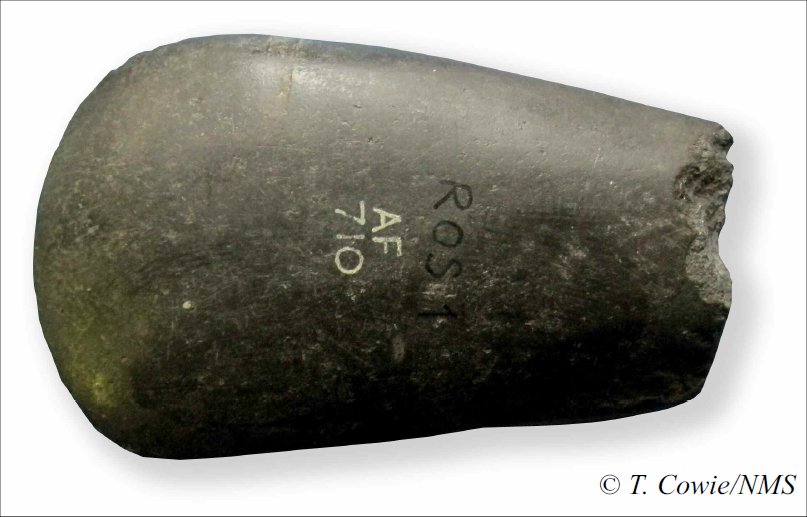
[Pic by T Cowie/National Museum of Scotland]
I have only one artefact from Ireland… this stubby axe from County Antrim in the north:
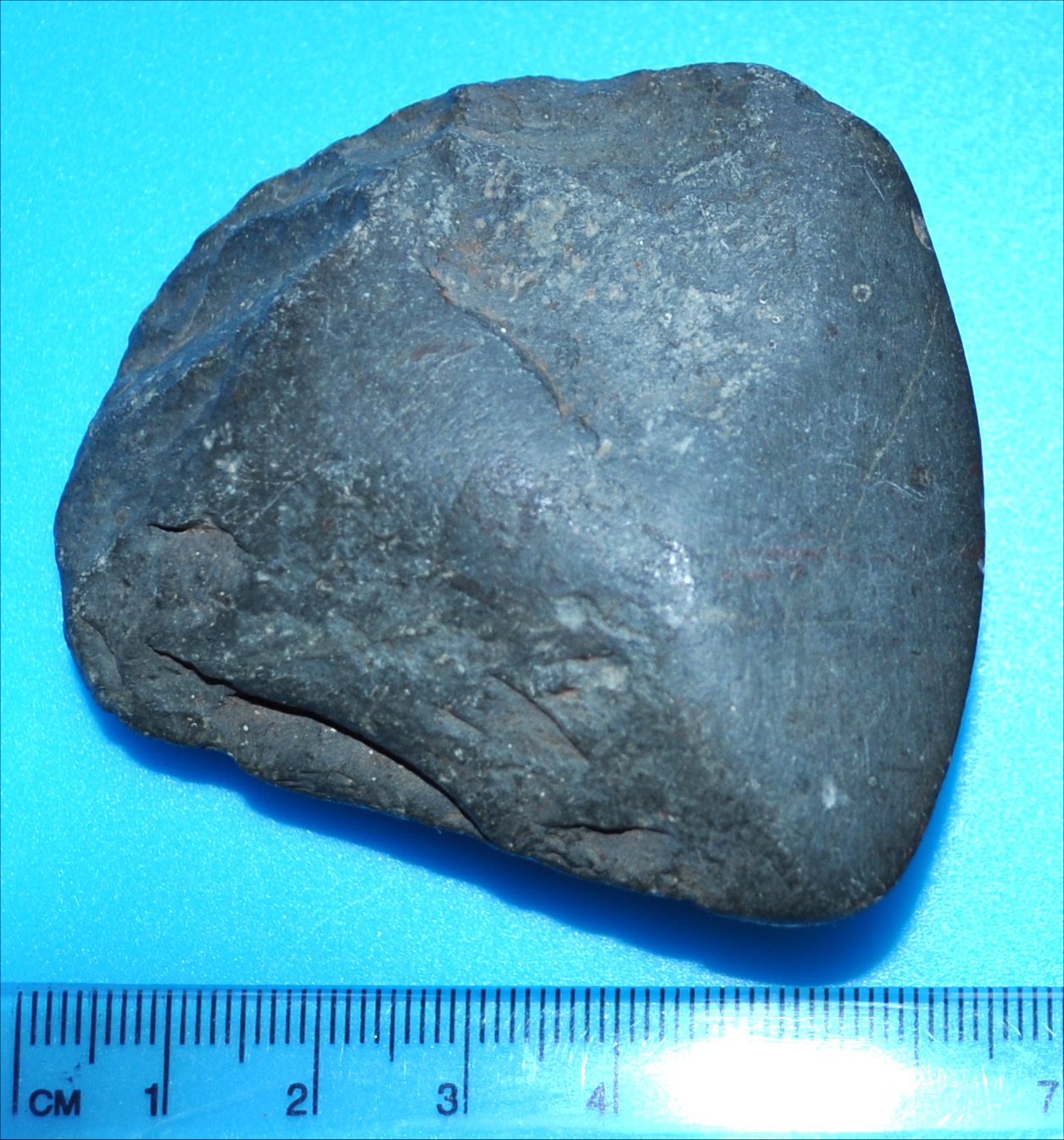
Interestingly, it’s made from a form of “greenstone” which is epidotised tuff and originates from Derbyshire in England. There was a large quarry and axe factory there which traded quarry blanks, roughouts and preforms as well as finished axes across the whole of the British Isles and into Europe. Despite the relatively crude form, it’s a finished axe, as evidenced by the polished bit.
Other artefact types do exist and they exhibit much more extensive use of bipolar reduction than seen in most areas of Britain. Bipolar reduction is the favoured technique where knappers are reliant on pebbles and small cobbles (as might be found on a beach) as their material source. As Irish cultures moved towards the Bronze Age, almost all small tools seem to have been made this way. These would be fairly typical for Mesolithic/Neolithic:
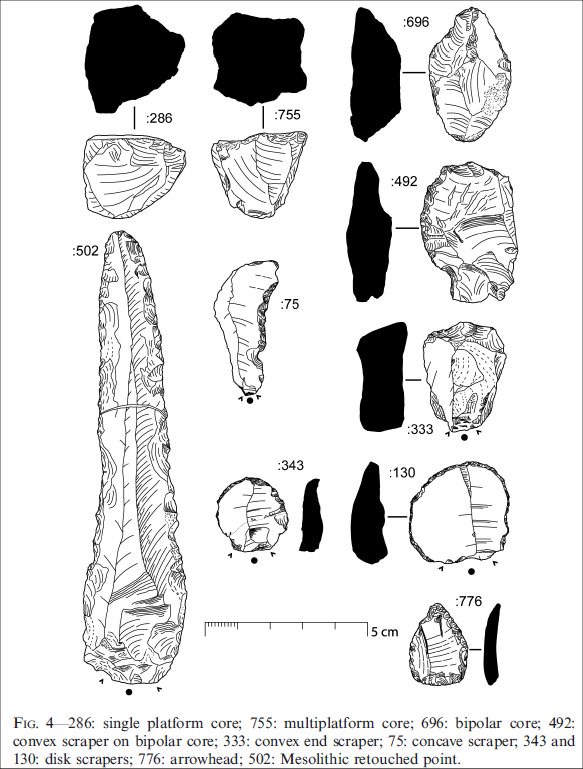
[pic from “Coastal Communities in Earlier Prehistoric Ireland” by Killian Driscoll, University of Barcelona]
At the height of the Neolithic, the population was probably between 100,000 and 200,000 people, but there was an economic collapse around 4,500 years ago (famine-related?) with a temporary population decline.
What all of that means is that initially there wasn’t really any such thing as an “Irish” lithic artefact – except in relation to raw material sources that were geographically unique. The population consisted of British people who brought their cultures, tools and tool industries with them. The same applies to British artefacts. The early British population consisted of European people who brought their cultures, tools and tool industries with them. In both cases, it requires a permanent established population to reach a point of competition with their neighbours for geographically distinctive tool industries to appear. That happened in both Britain and Ireland but much later in Ireland because it has a much shorter occupation history.
I keep six honest serving-men (they taught me all I knew); Their names are What and Why and When and How and Where and Who.
- Likes 1
Comment
-
Thank you so much, Great to find a person with similar interests
I have read all of Driscoll ,Hodgers,Woodman,Brady ,Knowles, Buick, ,the early bann blades and bronze age tanged and barbed points are my favorite ,and of course the the unique to Ireland Hollow core scrapers,
I am currently reading the Woodman book on the Knowles collection at NMI, I have yet to find examples in American types similar to the arrowheads found in Ireland, England and Denmark that are not pointed but chisel bladed have you?
Comment
-
You're welcome. I’m puzzled by what more you might need in the way of references or links to information if you’ve read all that lot! :laugh:
Incidentally, the hollow scrapers you refer to are certainly characteristic of the north of Ireland but not uniquely so. The form also occurs in England. This extract from “A Neolithic Site Northwest of Cambridge” [Marr -and- Burkitt 1922]:
“From a fairly large collection we srlected about thirty-seven specimens as shewing work designed to produce definite forms. Of these by far the most numerous are end-scrapers mostly with a steep end. No less than fifteen are of this character, one (unfortunately broken) having a fan-shaped retouch. In addition to the ordinary forms, there are two special ones: the first has two awl-like projections at the scraper-end, and the second is square-ended. Two hollow scrapers occur, one of much interest. The flake, two inches wide, is of irregular outline, but a hollow 7/8 in. across and ½ in. deep has been formed by delicate trimming recalling that of the well-known scrapers from the north of Ireland, of which a specimen is figured by Sir John Evans (Ancient Stone Implements, Fig. 226 a). Our specimen exactly coincides in shape and outline of the hollowed part with the one figured. One from Sheep's Green, in the Museum of Archaeology and Ethnology, has a similar hollow. It is of a greyish colour. A core scraper has been found, and two somewhat poor side-scrapers.”
No pictures in that paper unfortunately, but the UK PAS database also records examples from other English sites. Unfortunately, the site is down (maintenance?) at the moment. Just so folks know what we’re talking about, here’s some Irish examples:
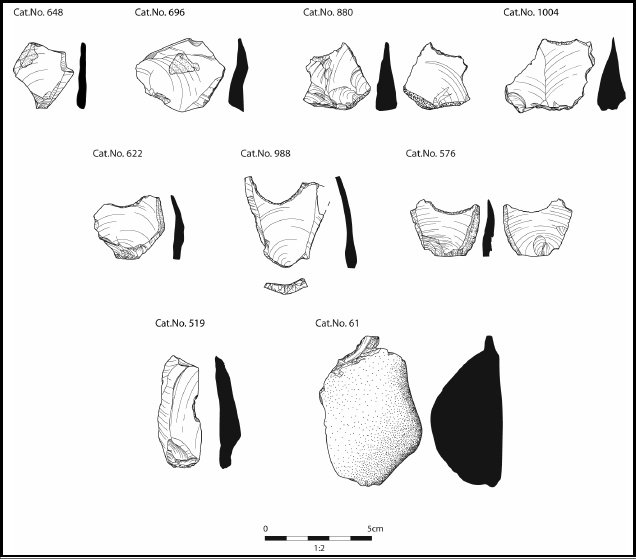
[Fig 7. Concave scraper flakes and concave scrapers from “Neolithic Tool manufacture on the Antrim Coast” (Robertson, Lochrie -and- Timpany in The Ulster Journal of Archaeology 2010)]
No, I’m not aware of North American arrowheads that have the chisel-edged form as such. Again, so folks know what we’re talking about, here’s some UK examples of transverse and chisel edged arrowheads from the Neolithic:

[Pic by Brian Burningham for Leicestershire County Council guide to flint tool types]
I keep six honest serving-men (they taught me all I knew); Their names are What and Why and When and How and Where and Who.
Comment
-
- Likes 2
Comment
-
Your great.... Well there is always more information out there, you can never say you know it all , in fact you just proved it, the the PAS report on hollow core scrapers, numerous scholars have stamped them Irish only
Science is only science when it is forever changing and growing.
Like the Clovis first debate scholars have staked there reputations on this claim, coupled with pseudo intellectuals joining in by owning knowledge simply by copy and pasting from the Internet .
Only to find science has moved on and other evidence comes forth.
I was just in Belfast museum and NMI will post some images when I return from traveling .
Would love to here from others regarding Tranverse arrowheads
Comment



Comment